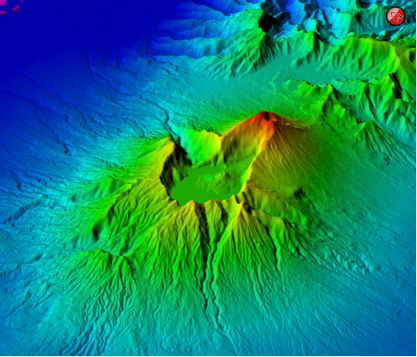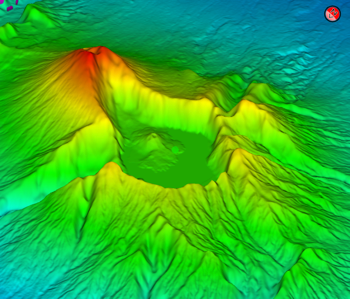Success Story on the use of EO to generate new and update existing geological maps in extremely geologically active, heavily clouded regions.
Provision of accurate 3D Mapping Data to generate new and update existing geological maps in extremely geologically active, heavily clouded regions is a challenge. The emergence of 3D radar mapping has proven to be a disruptive technology in this field.
Indonesia is a rapidly developing nation in South East Asia. Natural resource extraction and infrastructure improvement are keys to this ongoing development. In addition, as part of the Pacific Ring of Fire, Indonesia is extremely geologically active: earthquakes and volcanic eruptions have frequent impacts on people and property throughout the nation. Reliable geologic mapping is required to assist with Indonesia’s development goals and simultaneously reduce the risk of geological hazards on the population.
From a mapping perspective, areas near the equator (which Indonesia sits astride) represent a particular problem: much of the land-mass is almost continuously under cloud cover. Traditional mapping approaches use aerial or satellite photography as the foundation layer upon which all maps (paper or increasingly digital) maps are created. This means that many areas in Indonesia are not accurately mapped, since clouds cover the terrain, making repeat passes with aircraft or satellites necessary.
During the last 15 years, radar mapping has moved from a scientific curiosity to a fully-fledged remote-sensing technology. The advantage of radar waves is that they can penetrate cloud cover, and even operate in complete darkness, virtually guaranteeing coverage in a single pass. This reduces the cost, and greatly improves the “schedule reliability” of any tropical mapping project using radar. Astrium Geo-Information Services has the commercial exploitation rights to two radar satellites: TerraSAR-X and TanDEMX. This allows Astrium GEO to collect radar imagery and create 3D DEMs over any terrain surface.
Once the images and DEMs are collected, they require some manual interaction to fix any errors in the elevation model (terrain editing), adjust water elevations (hydro-enforcement) and perform Quality Control.
Because the areas involved for the two Geology projects were so large (several hundred-thousand km2), it was decided to partner with an Indonesian firm to undertake the manual terrain and hydro editing steps. Final Quality Control of the data was maintained by Astrium GEO. The Indonesian partners were then involved with the final packaging and distribution of the data to the Indonesian Government.
The partner firms were somewhat familiar with radar data, having previously purchased and distributed radar imagery from both airborne and satellite sources. One of the firms also had topographic mapping experience and contour generation experience using radar-derived DEMs. However, terrain and hydro-editing on the scale required for these projects was unknown to these firms. A strategy was developed to transfer knowledge and technology to these companies, so they could succeed in the short time-window required for these projects.
In order to save on software costs, which can greatly increase the internal cost and price of the overall project, it was decided to use freeware software as much as possible for the delineation of water bodies. A workflow was developed by Astrium GEO to integrate freeware software into the normal production process. Hands-on training was provided to the partner firms in radar interpretation, data-flow management and overall production management and reporting. Wherever possible, data and production information was shared online, so as to reduce costs and improve communication across six time-zones.
Regular on-line discussions were held to provide quality and production feedback to the partner firms. Metrics about quality acceptance (and failure) were provided to ensure that production processes were improved, and individuals re-trained where necessary.
The manual surveying of vast areas of Indonesia to create new and update existing geological maps is neither cost nor time effective. The only way to undertake such a task is through remote earth observation. With the weather and terrain challenges of Indonesia, the emergence of radar mapping and 3D radar mapping has proven to be a disruptive technology in this field.
For Astrium GEO, the inclusion of Indonesian partner firms in the production of DEMs is also essential. This inclusion allows Astrium GEO increased access to markets, and allows Astrium GEO the flexibility to add production capacity when necessary to undertake outsized projects very quickly.
The Indonesian Geological Survey now has imagery and elevation information for the majority of Indonesia, including some areas that have never been comprehensively mapped before. The actual generation of the geological maps is an internal process that will continue for some years.
Astrium GEO maintains its relationships with its Indonesian commercial partners. These production partners were able to reduce overall data production costs, and increase the speed of the overall product creation and distribution. The partners are now fully trained in radar DEM production, and stand available to assist with future production requirements in Indonesia and elsewhere.
- Service provider (©) Astrium GEO services
- Provision of 3D Mapping Data to the Indonesian Government Geological Survey
- Keywords: 2011 and 2012 / Minerals and Mining/ Map geological features /
- Production of 3D Digital Elevation Models (DEMs)



This page has no comments.